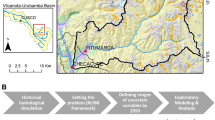Abstract
It is anticipated that global climate change will adversely impact source water quality in many areas of the United States and will therefore, potentially, impact the design and operation of current and future water treatment systems. The USEPA has initiated an effort called the Water Resources Adaptation Program (WRAP) which is intended to develop tools and techniques that can assess the impact of global climate change on urban drinking water and wastewater infrastructure. A three step approach for assessing climate change impacts on water treatment operation and design is being persude in this effort. The first step is the stochastic characterization of source water quality, the second step is the application of the USEPA Water Treatment Plant model and the third step is the application of cost algorithms to provide a metric that can be used to assess the coat impact of climate change. A model has been validated using data collected from Cincinnati’s Richard Miller Water Treatment Plant for the USEPA Information Collection Rule (ICR) database. An analysis of the water treatment processes in response to assumed perturbations in raw water quality identified TOC, pH, and bromide as the three most important parameters affecting performance of the Miller WTP. The Miller Plant was simulated using the EPA WTP model to examine the impact of these parameters on selected regulated water quality parameters. Uncertainty in influent water quality was analyzed to estimate the risk of violating drinking water maximum contaminant levels (MCLs).Water quality changes in the Ohio River were projected for 2050 using Monte Carlo simulation and the WTP model was used to evaluate the effects of water quality changes on design and operation. Results indicate that the existing Miller WTP might not meet Safe Drinking Water Act MCL requirements for certain extreme future conditions. However, it was found that the risk of MCL violations under future conditions could be controlled by enhancing existing WTP design and operation or by process retrofitting and modification.
Similar content being viewed by others
References
Cromwell J E, Smith J B, Raucher R S (2007). Implications of Climate Change for Urban Water Utilities. The Association of Metropolitan Water Agencies Report. http://www.amwa.net/galleries/climatechange/AMWA_Climate_Change_Paper_12.13.07.pdf
Interlandi S J, Crockett C S (2003). Recent water quality trends in the Schuylkill River, Pennsylvania, USA: A preliminary assessment of the relative influences of climate, river discharge and suburban development. Water Res, 37(8): 1737–1748
Jacobs K, Adams D B, Gleick P (2001). Chapter 14, Potential consequences of climate variability and change for the water resources of the United States. Climate Change Impacts on the United States—The Potential Consequences of Climate Variability and Change. Meilillo J, Janetos A, Karl T, eds. New York: Cambridge University Press
National Research Council (NRC) (2010). Adapting to the Impacts of Climate Change, America’s Climate. Progress Report of the Interagency Climate Change Adaptation Task Force—2010
Obolensky A, Singer P C (2005). Halogen substitution patterns among disinfection byproducts in the information collection rule database. Environ Sci Technol, 39(8): 2719–2730
Obolensky A, Singer P S, Shukairy H (2007). Information collection rule data evaluation and analysis to support impacts on disinfection byproduct formation. J Environ Eng, 133(1): 53–63
Salas J D, Delleur J W, Yevjevich V, Lane W L (1980). Applied Modeling of Hydrologic Time Series. Littleton: Water Resources Publications, 484
Skjelkvåle B L, Stoddard J L, Jeffries D S, Tørseth K, Høgåsen T, Bowman J, Mannio J, Monteith D T, Mosello R, Rogora M, Rzychon D, Vesely J, Wieting J, Wilander A, Worsztynowicz A (2005). Regional scale evidence for improvements in surface water chemistry 1990–2001. Environ Pollut, 137(1): 165–176
USEPA (2005). Water Treatment Plant Model Version 2.2 User’s Manual. Office of Ground Water and Drinking Water, United States Environmental Protection Agency, Cincinnati, USA
Whitehead P G, Wilby R L, Battarbee RW, Kernan M, Wade A J (2009). A review of the potential impacts of climate change on surface water quality. Hydrological Sciences, 54(1): 101–123
Author information
Authors and Affiliations
Corresponding author
Rights and permissions
About this article
Cite this article
Clark, R.M., Li, Z. & Buchberger, S.G. Adapting water treatment design and operations to the impacts of global climate change. Front. Earth Sci. 5, 363–370 (2011). https://doi.org/10.1007/s11707-011-0197-7
Received:
Accepted:
Published:
Issue Date:
DOI: https://doi.org/10.1007/s11707-011-0197-7




